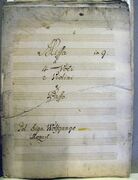Johann Michael Closner (1786–1860) and the historical music manuscripts and prints in the Trostberg City Museum
Helmut Lauterwasser
Wednesday, April 21, 2021

We have received the following from our colleague Helmut Lauterwasser (RISM Germany):
One of the most important tasks for RISM is to catalog historical sources of music also in small libraries, archives, and museums. In extreme cases one encounters collections that contain very few historical music sources, sometimes only a single one of them. Such institutions have, as a rule, no professional or personal resources that could allow for an appropriate, musicologically competent cataloguing of their musical sources. This holds true for countries that have been centrally governed for centuries, but even more so for Germany, which was split up into a number of small states and principalities up until the 20th century. For music historians, however, these holdings constitute an important building block. Firstly, because they often feature compositions that have never been disseminated beyond their immediate environment, and are accordingly not known from any other source; and, secondly, since they time and again include manuscript copies that shed light on the transmission and reception of works by great composers.
Both of these points are relevant also for the collection of the Stadtmuseum in Trostberg (D-TBh), the historical music sources of which are now exhaustively described in the RISM catalog. In the first half of the 19th century, it was a composer of undeniable talent, Johann Michael Closner, who defined the musical life of Trostberg as a church musician. Closner’s musical estate including numerous autograph manuscripts, as well as first editions of his works, has survived in its entirety in the local museum. The collection also features a manuscript copy of Wolfgang Amadé Mozart’s Missa brevis in G major, K. Anh. C 1.12 (RISM ID no. 1001121198), which originated in the monastery of Seeon, and is of some interest for researchers of the transmission of this composition.
It is especially the work on small collections with historically limited contents that offers the cataloguer insights, e.g. cross-connections with sources within or without the collection, that cannot be directly included in the catalog descriptions. There is also the risk that in the vast RISM dataset individual entries do not get the scholarly attention they would deserve. For these reasons a study of the Trostberg music collection and the Closner family has now been published online, seeking to provide these holdings with the necessary historical context. The text also offers the first assessment of the output of Johann Michael Closner as composer. Along the way the activities of his sons and grandchildren as members of the court orchestra in Munich are also described.
The full text of the article (in German) is available here.
Image: Cover of the set of parts for Mozart’s Missa brevis in G major, K. Anh. C 1.12, D-TBh, shelfmark KH 51. © Stadtmuseum Trostberg. Used with permission.
Share Tweet EmailCategory: Library collections

